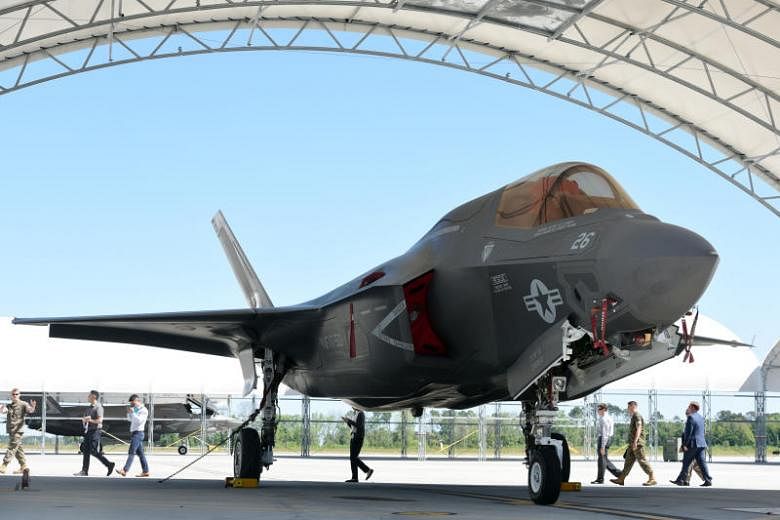SINGAPORE - Singapore will be seeking to buy four United States F-35 Joint Strike Fighter (JSF) aircraft for a start, with the option to buy eight more, as part of efforts to build the next-generation Singapore Armed Forces, said Defence Minister Ng Eng Hen on Friday (March 1).
In his speech during the debate on his ministry's budget, Dr Ng said the Ministry of Defence will issue a letter of request to the United States for an initial acquisition of four F-35s, with the option of a subsequent eight if Singapore decides to proceed.
As required by US law for foreign military sales, the US Congress must approve the sale of F-35s, Dr Ng said, adding that Singapore has the endorsement of both the US Administration and the Department of Defence for its proposed purchase.
He cited how US President Donald Trump wrote to Prime Minister Lee Hsien Loong last month welcoming Singapore's plans to acquire the F-35.
"During my meeting with Acting Secretary of Defence Patrick Shanahan at the Munich Security Conference two weeks ago, he also said that the US was greatly appreciative of Singapore's decision," said Dr Ng.
He added that the unit price of the F-35 JSF has been falling with "healthy" orders from the US and 10 other countries, including Britain, Italy, Japan and South Korea.
The current unit price of the F-35 ranges from US$90 million (S$121.7 million) to US$115 million, which is comparable to what Singapore paid for its F-15SGs.

He added that the total cost of ownership of a fleet of F-35s, including maintenance costs, will also be similar to that of the F-15SGs, and that Mindef will continue to work with the US Department of Defence to optimise the costs.
Mindef said in January that the Republic of Singapore Air Force and the Defence Science and Technology Agency (DSTA) have concluded that the air force should first purchase a "small number" of F-35 JSFs for a full evaluation of their capabilities and suitability before deciding on a full fleet, as the replacement for Singapore's ageing F-16s.
The F-35 JSFs and upgraded F-15SG fighter jets will form the RSAF's line-up of fighter jets post-2030, said Dr Ng on Friday, as he outlined steps to build the next-generation SAF of 2030 and beyond.
For instance, he said more advanced ships like the multi-role combat vessels, which can deploy unmanned air and sea drones, will replace the current fleet of missile corvettes by 2030.
There will also be a more protected and mobile army with platforms such as the next-generation Armoured Fighting Vehicle, set to be delivered this year as replacement for the M113 Ultras, and upgraded Leopard tanks.
Coastal homeland security efforts will also be enhanced. The SAF's network of optical sensors and coastal radars will be expanded, said Dr Ng, adding that unmanned surface vessels will be used for patrols starting in 2020.
"In all, the next-generation SAF of 2030 and beyond, with this full complement of assets in air, land and sea, will be able to defend Singapore for another generation. This is the SAF that will take us into and guard our future.
"This is the SAF on air, land and sea with which the next generation of Singaporeans will celebrate for SG75," he said.
Dr Ng also said the SAF will invest more into building training facilities, such as the 88ha training area about the size of Bishan, dubbed Safti City, which is "taking shape and on schedule".

More roads and bridges are being built so that motorised and mechanised troops in army vehicles can start training there this year, he said.
First announced in March 2017, the facility in western Singapore will complement traditional terrain with urban scenarios, with more than 200 buildings of different heights and types, to better train soldiers in a wide variety of operations in realistic settings, such as counter-terrorism and disaster relief operations.
He also gave an update on the expansion of training areas in Australia under the Singapore-Australia Comprehensive Strategic Partnership.
There will be new facilities such as the Instrumented Combined Arms Air Land Ranges and Urban Operations Live-Firing Facilities in Queensland.
When completed, the areas there will allow troops to train for up to 18 weeks annually, from the current six to seven weeks.
On the cyber front, Dr Ng revealed that the SAF will tap operationally ready national servicemen (NSmen) with IT expertise as a result of their civilian jobs or training, following efforts to recruit cyber-security specialists and to train full-time national servicemen (NSF) in the Cyber NSF scheme.
He said one example is the existing Expertise Conversion Scheme, which allows selected non-officer NSmen with industry expertise to become Military Domain Experts Scheme officers for cyber vocations.
"All of us have a part to play in digital defence for Total Defence. In Singapore's digital fortress, we are only as strong as the weakest link," he added, citing the recent move to add digital defence as the sixth pillar of the Total Defence concept.
Dr Ng also revealed that the Defence Cyber Security Centre, which comes under the Defence Cyber Organisation, has been set up.
Inaugurated by Defence Cyber Chief David Koh on Nov 16, 2018, the centre serves as the "nerve centre" for the defence sector against increasingly sophisticated and malicious cyber threats, said Mindef in a separate statement.
It oversees cyber-security efforts for the SAF's military networks, Mindef's and SAF's operational support IT systems, and IT systems for the DSTA and DSO National Laboratories.
Anomalies detected in one network will be shared across the sector to heighten defences against a possible attack.
Dr Ng also announced the set up of the Defence Cyber Incident Response Teams, which are made up of trained professionals responsible for responding to cyber incidents within the defence sector.
Its members come from Mindef, SAF, DSTA, and DSO National Laboratories. Each team is trained to conduct investigations, digital forensic analysis, and malware analysis.
The teams can also be deployed to support other national cyber-security agencies, such as the Cyber Security Agency.


